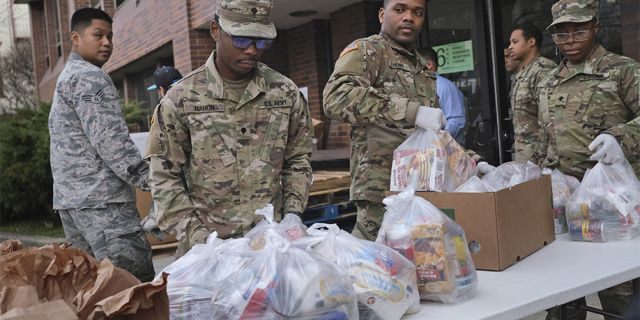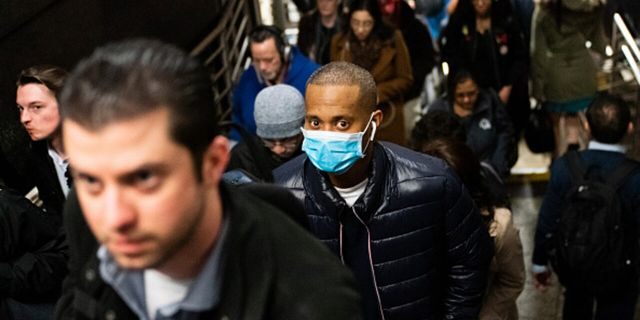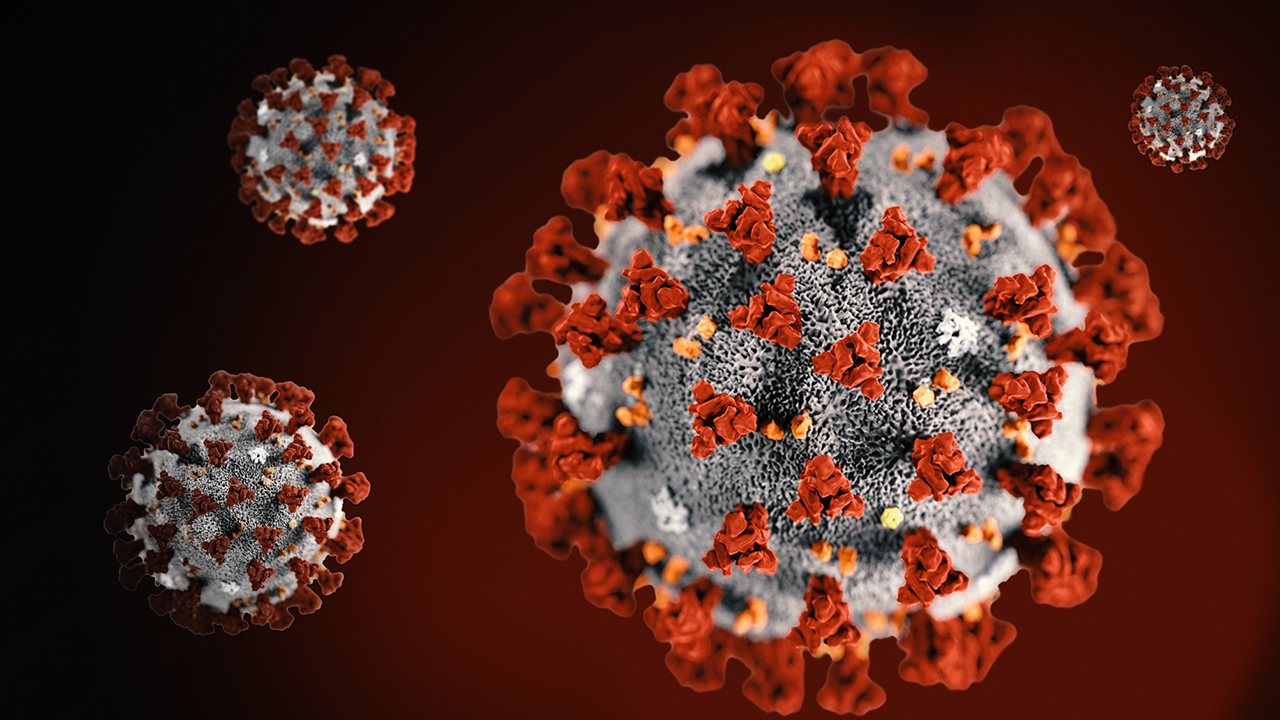[ad_1]
As coronavirus continues to spread across the United States, the quest to combat the global pandemic is being hampered by testing kit shortages and a fear that the materials needed to make more may soon run dry.
Officials estimate that only around 8,500 people in the U.S. have thus far been tested for the pathogen, sparking fear that the numbers who have contracted it – and are continuing the spread – may be drastically higher. Meanwhile, other countries encountering a severe outbreak, such as South Korea, are said to be testing upward of 10,000 people per day.

Members of the New York National Guard help to organize and distribute food to families on free or reduced school lunch programs in New Rochelle, N.Y., Thursday, March 12, 2020. State officials have set up a “containment area” in the New York City suburb. (AP Photo/Seth Wenig)
Yet, as of Monday, the Centers for Disease Control and Prevention (CDC) simply stopped publicly tabulating the number of tests conducted.
“With viral infections, there will be a period when the agent is not yet detectable but may be transmissible. There will also be a period when persons are asymptomatic or not yet severely ill. The initial tests were in short supply, and had sensitivity problems,” Dr. Stanley H. Weiss, a professor of Medicine and Epidemiology at Rutgers New Jersey Medical School, told Fox News. “The initial case definition used for surveillance and testing was strict; perhaps that was necessary due to logistical issues, such as lack of tests. In any case, the number of actual infections was grossly misestimated and the magnitude of spread, and the existence of community spread, was missed.”
CORONAVIRUS FORCES THESE MAJOR US CANCELLATIONS: ENTERTAINMENT, NBA, MLB SPRING TRAINING AND MORE
Laboratories nationwide have this week lamented the dwindling of supplies necessary to run tests. The American Society for Microbiologists voiced worry this week that increased demand is draining testing supplies. And medical professionals have expressed concerns over the escalating demand and anxieties surrounding the novel condition.
Dr. Damon Raskin, a Los Angeles-based internal medicine specialist, concurred that the chaos surrounding the unfurling crisis is nothing short of “overwhelming.”
“There is a shortage of testing kits because there are limited supplies of the reagents used for the tests,” he underscored. “There are many patients walking around with this virus who do not know it. They may have mild common cold symptoms and just get over it without needing medical attention. But they can spread to others unknowingly.”

In this Tuesday, March, 10, 2020 photo, paramedics test samples taken from patients suspected of being infected with the new coronavirus, at a laboratory in the southwestern city of Ahvaz, Iran. For most people, the new coronavirus causes only mild or moderate symptoms, such as fever and cough. For some, especially older adults and people with existing health problems, it can cause more severe illness, including pneumonia. (Amin Nazari/ISNA via AP)
Earlier this year, in the initial phase of the virus morphing from its origins in Wuhan, China, diagnostic testing was restricted to just 100 public-health labs, and testing needed to be run through the CDC. The FDA eventually expanded the number of approved labs, but reports of inconclusive results and even testing refusals quickly proliferated, as only those who had traveled from China were given the approval to be examined.
HOW MANY CORONAVIRUS TESTS ARE AVAILABLE, HOW MANY ARE NEEDED?
Weiss said it isn’t entirely clear why the CDC chose to develop its own tests, but the reason likely stems from the complex regulatory issues which are not designed for such a crisis. Indeed, much of the delay in rollout has been obstructed by age-old, draconian regulations and red-tape that has long instituted federal and state governments. This includes stringent restrictions on re-purposing existing tests for other uses. The FDA nonetheless has pushed back on accusations of not moving fast enough, stating that its emergency authorization for laboratory testing was immediately brought to bear.
Yet given the distress over possible shortages required for the kits as demand escalates, many medical facilities are still limiting testing to patients considered to be high-risk or with verified close contact with a person known to be infected. Rather, official guidelines are urging those with mild symptoms to self-quarantine or avoid public places until their condition returns to normal. But in some cases, a transmitter will have no notable symptoms at all.
Based on a rough estimate, Eve Walter, an epidemiologist and associate professor at New York’s Icahn School of Medicine at Mount Sinai, surmised that for every person who tests positive there is likely 2.5 persons infected by them, and walking around asymptomatic.
Moreover, the issue of testing availability has been further complicated by the insistence from the administration that kits are available for anyone who needs them.
“Anybody that needs a test, gets a test. They’re there. They have the tests,” President Trump said during a recent visit to the CDC in Atlanta. “They’re there. They have the tests. And they’re beautiful.”
That has many in the industry scratching their heads.
“The testing process has been difficult. Initially, the test kits were flawed, and burdensome rules and strict criteria contributed to hospitals and doctors struggling to test widely for the coronavirus. These delays have made it impossible to get a true picture of the outbreak,” explained Dr. Azadeh Shirazi, Disease and Prescription Specialist, and CEO/Founder of the La Jolla Laser Surgery Center. “There are enough tests at hospitals and designated facilities for those that are symptomatic. The challenge is testing those who have come into contact with someone who has it but they’re not symptomatic.”

NEW YORK, NY – MARCH 09: A man wearing a protective mask is seen on a subway platform on March 9, 2020 in New York City. There are now 20 confirmed coronavirus cases in the city including a 7-year-old girl in the Bronx. (Photo by Jeenah Moon/Getty Images)
As of Friday, the U.S. has more than 1,600 laboratory-confirmed cases, resulting in some 41 deaths. But such a figure is set to spike exponentially – although experts caution that the real figure may never be properly identified, especially given nervousness over testing accessibility.
However, some in the medical arena contend that there really could not have been any reasonable initial containment.
“The spread of this virus is somewhat unique. A large proportion of those infected show little to no symptoms and the virus can be shed even when a person is asymptomatic,” Walter said. “We have no vaccine – which is the best way to stop spread — we have limited tests, second-best way, and it’s hard to know who to quarantine when many are asymptomatic.”
CORONAVIRUS: WHAT YOU NEED TO KNOW
There are a few different tests, Walter explained, the first being a throat swab to detect for antibodies, the second being a blood test to identify white blood cells and antibodies, and the third a respiratory sample, which she highlighted as the most accurate for current conditions.
“The antibody tests can yield faster results. We have been focusing on the respiratory sample – other countries like South Korea use the throat swap and, as a result, have tested way more people. Again these antibody tests are best to know prevalence – but they are not yet specific to say if the person is currently shedding the virus or if they will get COVID-19,” she continued. “In the U.S. we have been using the respiratory test which is harder and slower. I guess it’s a judgment call.”
CORONAVIRUS OUTBREAK ‘AT BEST COULD BE 10 TIMES WORSE THAN BAD FLU SEASON,’ EXPERT WARNS
That comes with its own points of contention. One prominent red flag raised by doctors is the turnaround time on such tests. While some hospitals and clinics can offer a fast diagnosis in just a matter of hours, other less-equipped centers are required to send their specimens to commercial facilities, meaning it can take up to four days for positive identification – and in that time, it’s unclear how many more individuals may be exposed.
Yet in any case, industry leaders vow they are working above and beyond to ensure the supply meets the demand as the rash of cases across the country soars.
“We are ramping up production at manufacturing sites in Hilden, Germany and Barcelona, Spain, moving to three shifts that will work seven days a week, hiring new staff, and using manufacturing capacity at a Maryland facility in the U.S.,” Qiagen, a leading manufacturer of kits that endeavor to extract RNA from nasal swabs and thus diagnose the virus, stated Thursday.
The CDC did not immediately respond to a request for comment.
And while the medical industry may differ when it comes to the test types and early containment viability, the overarching consensus when it comes to squashing the spread at this critical point in the game remains clear.
“The biggest concern is we are not testing enough,” Walter stressed. “Given the potential invisibility of this virus, the best way to contain it would be more robust testing.”
[ad_2]
Source link

